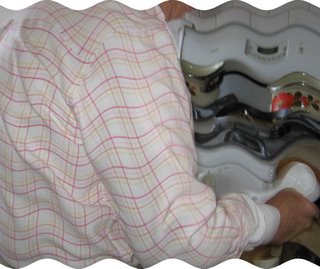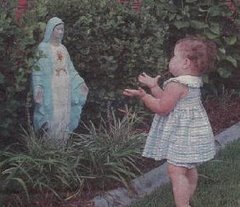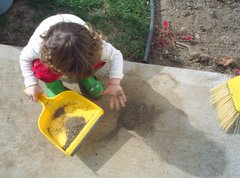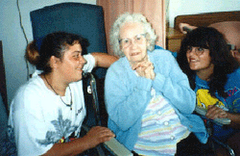[This past week as I was making lunch for some grandchildren, they begged several times, "Grandma, tell us a story." So I made up and told the tale of "The Boy with the Green Face." I hope you enjoy it, too.]
A long time ago in a far away country, a young boy with a green face lived in a small village. His hair was brown, his teeth were white, his eyes were blue, and his nose and features were quite handsome, but....his face was as green as fresh lettuce. He had tried to scrub off the green when he was younger, but his face always remained green. His parents had white faces, and his Dad told him that he thought one of his great great grandfathers had had a green face.
The other boys in the village did not have green faces, and frequently taunted and teased the boy with the green face. Sometimes they called him "lettuce head" or "Martian boy," and the lad was very sad when he was called those terrible names. His real name was Mack, but one day one of the other boys decided to call him McGreen, and the name stuck. McGreen had tried to make friends several times, but it seemed no one wanted to play with someone who looked so different.
Once the school had sponsored a contest to determine the smartest boy in the village. McGreen was determined to show that, in spite of his green face, he was as intelligent as the rest of his classmates. When McGreen won, he had expected to hear at least one person say "good job" or "congratulations", but instead, the other boys had walked away to play another game without him.
McGreen was a good worker and helped his parents with their crops and animals. When his parents said he could play, the boy usually headed over the hill to the nearby valley where deep woods surrounded a clear stream. He played by himself and pretended to be an early explorer or a famous knight on a pilgrimage. Occasionally, he found interesting things, such as an iron ring from an old horse harness, and pieces of broken pottery that had had beautiful pictures. Once he found some arrowheads and a spear head. A few times he was frightened by the noises of the forest, but he gradually learned to be at home in the woods and by the stream.
One day he went to the point where the valley stream joined the larger river from the north. As he searched for small flat stones to skip across the river, he saw a boat coming downstream. Five men pushed their oars against the river bottom to make the boat go against the current and approach the shore. McGreen watched as one man yelled, "Push hard, push us to the bank!"
The boat approached near where McGreen was standing. Two men stepped out of the boat into the shallow water, while the other three stayed in the boat and kept the boat from being carried further downstream.
"Do you live around here?" asked the taller man who came ashore.
"Yes, my parents have a farm over there," said McGreen, pointing over the hill. He noticed a roll of ivory paper under the man's arm.
"We're looking for a guide to this country," said the tall man. "Our map tells where we may find something that was lost and buried many years ago. Can you help us?"
"I'd like to help," said McGreen somewhat reluctantly, and he squirmed as the other men seemed to be staring at his green face.
"We need someone who is very familiar with this valley," continued the tall man. "Someone who is smart, and who can help us find what we need to know. What's your name?"
"I'm McGreen," said the boy. He added, " I know the woods, and where the hills have springs, and I have explored several miles up the valley stream." He added, "There's an old man in our village who knows this woods, too, but he can't walk very well."
"Then you're hired, McGreen!" said the tall man, who proceeded to pull a map from under his arm. "My name is Peverson. We're looking for an old church about two miles up your valley, and we need to find a very large tree and a cliff, too."
"There's no church, and no cliff, either, Mr. Peverson," said McGreen in puzzlement. "Perhaps this is the wrong valley."
"It's got to be the right valley," said the tall man. "Come, let's walk a ways up along the stream."
The boy walked ahead of the five men, and the men discussed their journey to reach McGreen's valley. One of the men who had stared earlier at McGreen's face suddenly said to his friend, "I didn't know there was anyone with a green face in this country."
"I didn't either," said the other man. "I thought this area had all white faces."
"What do you mean?" said McGreen, as he stopped walking and turned around to face the men.
"Well, you have a green face. That's sort on unusual in this area, but not in our villages. We live with both white faces and green faces. About half and half, I would suspect."
"Really? Even boys have green faces?" said McGreen, who could hardly control his excitement.
"Yes, we thought all the Greens lived with us. Are there any more like you? asked the man.
"No, I'm the only one," said McGreen sadly. And the boy began to think about how he could join the men and travel back with them to meet other boys with green faces.
McGreen and the five men had travelled about two miles up the path along the stream, when Peverson stopped and said, "The church has to be near. I'm sure of it."
Peverson talked further about the old church, a large tree, and a rock cliff that were shown on the map, but there were many questions. McGreen asked how old was the church, did it have a steeple, was it made of stone, was there a path from the church to the stream, and on what side of the stream were the church and cliff. By answering these questions, Peverson led McGreen to conclude that the church might be found on a slightly elevated knoll on which several large trees grew. "I think that is where the church is located," said McGreen.
The men and the boy with the green face approached the site and the boy told how he had once found parts of a rock foundation and a stone path when he had played in this area. The square stones of the path were located after soil and leaves were scraped away. The foundation was all that remained of the old church.
"We thought the walls of the old church would be still standing, but we were wrong," said Peverson. "Now where is the large tree?" He looked at his map again. "The tree should be to the southwest, but I'm not sure how far."
"What tree? There are lots of large trees near the church foundation," said McGreen. "May I see the map?" He looked and saw that no trees seemed large enough to correspond with the age of the obviously old map. McGreen walked to the southwest looking carefully for large stumps because he suspected the old tree had died many years before. No stumps were seen. Then he thought that perhaps another tree had grown up where the old tree had once stood. He began to examine the ground near the trees that he thought might have grown out of the stump of the very large old tree on the map. Sure enough, McGreen found one tree where at the base there appeared to be projecting stones. When he moved the leaves and sticks away, there was the rotting stump of the old tree and the stones that had been moved to the surface by the tree's large roots.
"The tree was here," said McGreen with a sureness in his voice that seemed unusual for a 12-year old. "Now let's find the cliff."
"It's in the same direction as a straight line drawn from the church through the large tree," said Peverson.
McGreen led the way up the side of the hill. The path was steep and covered with brush and McGreen knew this area well because he had played here many times before. He struggled to concentrate on finding his way but he was distracted by thoughts of other boys with green faces--just like him. A toad jumped out of the bushes onto a rock, as if to say, "catch me if you can." McGreen looked carefully at the rock. Cliffs fall down in rock pieces, he thought. So with the men's help, he broke through the tangled underbrush to climb further. Finally the cliff appeared, covered in moss. "This is the cliff," said McGreen.
"Look for a marker," said Peverson. "I don't know what kind of marker, but it should be obvious. We need to dig below the marker."
"Here's a flat rock," said McGreen.
"There's nothing unusual about a flat rock," said one of the men.
McGreen was insistent, "I'm sure there was something mounted on this flat stone." He looked intently at the stone and then scanned the cliff wall. Nothing seemed obvious. McGreen next gazed down the hill. Other stones appeared broken below. McGreen descended a few steps to the broken pieces of rock and examined several pieces that seemed different. "They've been painted, or at least once were."
Peverson was excited, "You've found it! It's a statue of our Lady that once stood on the flat stone. The statue is broken, but the flat stone seems undisturbed! He and another man tried to move the stone, but it was too heavy. "Help me move it out of the way," said Peverson. Three men were able to move the stone was out of the way, and one man used a shovel to dig. Within an hour, they had found the object of their search, a black iron box with length, breath, and height of a man's arm. The box was lifted to the surface and Peverson took a key out of his pocket to open the lock.
When the lid was opened, the men knelt. Peverson gently lifted a white linen-wrapped object out of the box and unwrapped it to reveal a gold chalice. "May Jesus Christ be praised that we found these sacred objects," he said slowly and reverently. He saw two other white-wrapped objects in the box, and immediately knew they were the ciborium and the monstrance. Peverson then rewrapped the chalice and replaced it in the box with the other two objects. After closing the lid, the men arose and Peverson told the story to the boy with the green face.
"McGreen, over two hundred years ago infidels invaded our land and sacked our villages. Before they burned the churches, the men of our village hid the sacred vessels below the statue of Our Lady in the Grotto by the cliff. Our great-great grandparents retreated to the mountains where we now live. We found this map recently and the sacred objects will now be restored to the new church we have built."
"May I please come with you, Sir?" asked McGreen. "I would love to see your land and your church."
"You'll be our guest of honor," said Peverson. "You'll also get to meet many of your own kind. There are lots of young men and boys who look like you. Let's go to your farm and tell your parents what has happened. I'm sure they will be glad to give you permission for your visit to our mountain village."
Of course, permission was granted by McGreen's parents but they did insist their son be returned within ten days. He had a wonderful time in Peverson's village and met many young boys with green faces. They listened intently as Peverson told them how McGreen had solved the great puzzle of where the sacred vessels were secretly stored. McGreen returned home to his parents after ten days, but as he grew older, he made other visits up the river to be with the people with green faces. Finally he met the girl who became his wife and decided to make the mountain village his new home. Naturally, all their children had green faces.
Daily Rome Shot 1528
10 hours ago












